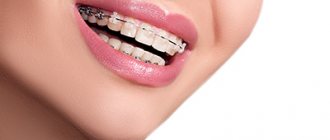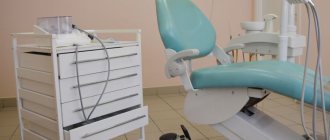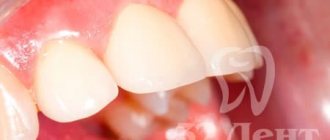What qualities should dental materials have?
- Do not cause allergic reactions;
- Do not contain harmful toxic substances;
- Do not create conditions in the oral cavity for the deposition of tartar;
- Maintain a smooth surface so that no particles of food remain in cracks or pits during food consumption;
- Prostheses must be resistant to mechanical loads so that they do not change their shape during use;
- Possess anti-corrosion properties;
- Be flexible during installation and rigid after completion of work.
When carrying out implantation and prosthetics, it is important to create an imitation of naturalness. That is, the mouth should close freely and the jaws should fit well together. It is important that the shade of new teeth does not stand out against the background of old ones. A person’s speech should remain coherent, and the timbre of his voice should remain the same.
Medical Internet conferences
Scientific supervisor: senior lecturer of the Department of Medical Biophysics named after. prof. V.D. Zernova I.V. Shcherbakova
Currently, more and more people are turning to dentists for help in the hope of restoring the integrity and aesthetic appearance of their teeth. In this regard, the search for appropriate dental materials has become more important than ever. In this article we will try to identify and compare the main physical characteristics of a number of materials that determine properties that are significant for dentists.
Many authors note that the problem of rehabilitation of patients with dentition defects is one of the urgent tasks of modern dentistry [1-4]. Thus, according to statistics, about 90% of Russians over 40 years old have at least one lost tooth [5]. In this regard, current trends include the expansion of dental implantation techniques [6]. At the same time, most patients have a low level of knowledge about the method and possibilities of using implants in the treatment of adentia and other dental diseases [7].
Every person strives to look good and give others a snow-white smile. However, bad habits coupled with hereditary factors can deprive this pleasure. This is where qualified assistance from a dentist with extensive knowledge of the materials and technologies used is required.
The most important in dentistry are the physical characteristics of the materials used - such as mechanical strength, melting point, elasticity, casting temperature. It is the physical characteristics of the material that largely determine both the possibility of its use in dentistry (for example, for the manufacture of an implant) and long-term service life [8].
Our comparative study of the physical characteristics of materials used in dentistry allowed us to compile the following table.
One of the fairly economical gold-containing alloys used for crowns and bridges is Harmony 2. Its advantages include mass availability and the ability to add shine through conventional polishing [9].
Gold-containing alloys used in dentistry also include Brite Gold XH and d.Sign 98. Their positive aspects are the absence of palladium, silver and zinc in the material, the properties of high-temperature strength, good compatibility with ceramics, and a pleasant golden color.
At the same time, it should be noted that applying silver-based antimicrobial biocomposite coatings to the surface of an intraosseous implant can reduce the rehabilitation time for patients and increase the efficiency of implantation [10].
It is impossible not to mention such an alloy as Callisto 75 Pd. It is an economical palladium-based alloy for ceramic veneering using the layering technique. This alloy has many positive aspects - excellent physical properties with high strength characteristics, convenient casting and melting temperatures, and, what is especially important for dentists, favorable polishing and processing properties.
The “colleague” of this alloy is Callisto Implant 33, intended for fired ceramics. This alloy has a reduced gold content in its composition, and the main advantage is its affordable price and efficiency. Dentists value this alloy for its excellent physical properties that make it possible to comfortably process this material, its strength characteristics, and ease of processing and polishing.
An analysis of the table allows us to conclude that in terms of strength characteristics, the alloy with a high gold content is the leader, and in terms of aesthetic properties, white alloys are in the lead.
It is very important to understand that the properties of materials that are important to dentists are determined by the physical characteristics of these materials. Today, based on the results of the comparison, it is possible to distinguish an alloy with a high gold content, since it has the best physical properties (hardness, density, elasticity). At the same time, from an aesthetic point of view, white alloys have the best properties.
The importance of the design features of materials used in dentistry should also be emphasized [11]. For example, the connection of elements of an intraosseous structure in the form of a combination of a cone and a polyhedron provides a more uniform distribution of stresses and, accordingly, a longer service life of such a structure, which is successfully used to eliminate defects in the dentition with partial and complete edentia [12], and in some cases the use of endosseous cylindrical implants [13].
Speaking about the development of implantology, one cannot fail to emphasize the possibility of modeling a future artificial tooth on a computer. The development of implantology occurs in parallel and in connection with computer modeling [14-15]. Careful study of various opportunities - both existing and emerging in connection with the development of sciences - is the key to the formation of a competitive specialist in the field of dentistry.
What is needed for quality work?
Recently, the requirements for the quality of treatment are constantly increasing, and the level of services is rising. In order to offer the patient effective and painless treatment, it is necessary to correctly select the necessary materials. Therefore, the manufacturer chosen by the doctor plays a special role here.
It is important to understand that cheap products are not always of high quality, and not every client can afford expensive ones. Therefore, the doctor needs to find a middle ground where the price is optimal and the quality is decent.
Basic materials for dentist work:
- Dental materials that are necessary for filling canals and teeth;
- Tools for restoring the standard tooth shape;
- Disinfectants for working with tools and reusable surfaces. Allows the removal of microorganisms, ensuring strict compliance with sanitary requirements;
- Anesthetics are necessary for pain relief during planned procedures. Most procedures are painful, so anesthetics should be purchased in large quantities;
- High quality suture material. It must be safe for health and not cause allergic reactions in the body;
- Tools and equipment: scalpel, burs, tartar and plaque removers, tweezers, mirrors.
The above dental materials are necessary for surgical, endodontic, and implantation procedures. They are also necessary for the treatment of teeth and gums. The use of these tools ensures a high-quality work result, which is important for the doctor and the patient.
Dental community
21.06.2020, Site section: Current articles. Dentistry. Health care organization. Right.
“Pediatric Dentistry and Prevention”, No. 2 - 2020
Skripkina G.I., Doctor of Medical Sciences, Associate Professor, Head of Department Garifullina A.Zh., Candidate of Medical Sciences, Associate Professor Breslavskaya E.A., Clinical Resident
Department of Pediatric Dentistry, Omsk State Medical University
Summary
Relevance: Light-curing composite materials have a large number of indications for use and are actively used by dentists in clinical practice. The properties of these materials vary depending on their composition and filler size. We conducted a survey of dentists and therapists in public and private dental clinics in Omsk to determine the compliance, objective indicators of the physical and chemical parameters of the composite materials under study and their subjective assessment by doctors using these materials in their work.
Purpose: comparison of objective indicators of various properties of photocomposite materials with the subjective assessment of dentists.
Material and methods: study of the physicochemical properties of light-curing composite materials most often used in the practice of Omsk dentists in public and private clinics. A research design was developed and a survey of 148 dentists in Omsk was conducted to determine the subjective assessment of these materials.
Results: a comparative analysis of objective and subjective indicators of composite materials was carried out.
Conclusions: the data on the physical and chemical parameters of photocomposite materials fully correspond to the subjective assessment of dentists in Omsk.
Key words: Dental materials, composite materials, fluid-flowing composites, properties of materials, survey, questionnaire, dentists.
Introduction
Modern practical dentistry predominantly uses dental photocomposite filling materials for the treatment of carious and non-carious dental lesions due to their positive aesthetic and mechanical characteristics [1, 2, 3, 4]. Composite materials allow the doctor to carry out gentle preparation of teeth, restoration of teeth with defects of various shapes and configurations and have a number of physical and chemical advantages: high aesthetic properties, high strength, a wide range of colors [5, 6, 7], the ability to model and give an anatomical shape to the damaged crown part of the tooth, a stronger connection with the hard tissues of the tooth, better marginal adherence to the hard tissues of the tooth, biological tolerance to the tissues of the oral cavity [8, 9, 10, 11, 12, 13]. But such materials are also imperfect and are constantly being improved [14, 15, 16, 17].
The purpose of the work is to compare data on the objective physical and chemical properties of a number of composite materials with a subjective assessment of the same materials, in order to formulate practical recommendations for dental therapists.
Objectives: 1. Assessment of physical and chemical parameters of a number of composite materials. 2. Determination of subjective assessments of photocomposites by dentists in Omsk. 3. Analysis of objective and subjective parameters to formulate practical recommendations for dentists and therapists.
Material and research methods
Today, the market offers a huge selection of photocomposite materials from various manufacturers, both foreign and domestic. For the study, materials were selected that are most often used in the practice of Omsk dentists in public and private clinics based on the data obtained from a questionnaire survey in order to give a personal subjective assessment of these products.
The following methods were used in the work: sociological, analytical. We developed a research design and developed a questionnaire to compare the subjective assessment of composite materials with their physicochemical parameters.
Studies of the objective physical and chemical properties of the materials under study were carried out in June 2022 by a certified tester under the supervision of the head of the Research Center B.V. Ryabokon. The tests were carried out in accordance with national standards: GOST R 56924 - 2016 (ISO 4049 - 2009) “Dentistry. Polymer restorative materials" and GOST 31574-2012 "Dental polymer restorative materials". An objective assessment of the properties of materials is represented by the following parameters: depth of curing, diametric tensile strength, bending strength, consistency.
Our work involved the evaluation of the following composite materials (names/characteristics correspond to official registration documents):
- Filtek Ultimate Universal (3M ESPE) is a universal restoration material.
- Estelux NK (Stomadent) is a nanohybrid composite material.
- DentLight (VladMiVa) – microhybrid composite.
- Filtek Ultimate Flowable (3M ESPE) is a fluid-flowing restoration material.
- FlowRest (Stomadent) – low-modulus (flowable) composite
- DentLight Flow (VladMiVa) is a flowable composite.
Materials differ not only in price category, but also in their properties, which are reflected in the work process and its results. For the first three positions (packable composites) in the official registration documents, only the Estelux NK material from the Stomadent company contains the word “nanohybrid”; but in two other cases, both manufacturers position these products as “nanocomposites” and as materials made with the use of nanoadditives, as indicated on the manufacturers’ websites, as well as in their catalogs and presentation materials.
Research results and discussion
A questionnaire survey was conducted among 148 dental therapists in Omsk. In government institutions, the number of respondents was 92. Of these, 44.44% had work experience of more than 10 years, 22.22% had 5-10 years of experience, and 33.33% had less than 5 years of experience.
The number of surveyed doctors from private clinics is 56. The smallest number of them - 9.52% - are specialists with more than 10 years of work experience, 38.09% have less than 5 years of experience and the majority - 52.38% - have been working for 5-10 years.
When carrying out restoration, 59.25% of dental therapists in public clinics use a combination of condensed and liquid (flowing) composites, the remaining 40.74% use only condensed composites. In private institutions the situation is very different. The combination of “condensable and liquid (flowable) composites” is used in restoration by 95.23% of doctors.
The largest number of surveyed doctors from public and private clinics - 85% - use fluid-flowing composites when sealing fissures. 78% use these materials when filling using the layer restoration method. 77% - to restore minor enamel chips. 59% of doctors prefer liquid materials when filling Black class 2 cavities using the tunnel preparation technique. There was a slight majority of votes in favor of private practice. When restoring the marginal seal of fillings, flowable composites are used by 50% of doctors. Small cavities on the chewing surface are filled with liquid materials by 59% of surveyed doctors. Wedge-shaped defects and damage in the cervical part – 43%. Black class cavities 3 and 4 – 30%. 36% of respondents fix fiber systems and 21% fix splints using flowable composites. Most of them are doctors at private clinics.
Doctors use condensed composites in the following clinical situations. 95% use these materials to fill cavities of class 1 and 2 according to Black. 78% - when filling using the layer restoration method. 91% of doctors model the tooth stump with condensed composites. The smallest number of doctors in both groups – 13% – use these materials in the manufacture of indirect restorations. In the last two cases, there is a slight advantage in favor of private clinics.
An objective assessment of the properties of materials is reflected in Table No. 1 and is represented by the following parameters: depth of curing, diametric tensile strength, bending strength, consistency. In the note column, a description of tactile properties and strength is highlighted.
Table 1. Objective assessment of the physicochemical properties of the materials under study
| Name of material, Color of material | Curing depth, h mm | Strength at diametrical rupture, MPa (not less than 34 MPa) | Bending strength, MPa (not less than 80 MPa) | Consistency, mm | Note | ||||
| According to the manufacturer's instructions | h, mm in 10 sec. | ||||||||
| Curing time sec. | h, mm not less | h, mm actually | |||||||
| 1. | Filtek Ultimate Universal Restorative, EA3 | 20 | 2 | 2, 57 | 2, 18 | 60, 9±4, 3 | 119, 7±19, 3 | 16.5x16.5 | + Dense, but very flexible, easy to model, high strength. — Chips on the cured sample. |
| 2. | DentLight, DA3 | 30 | 2 | 2, 03 | 1, 60 | 48, 5±6, 5 | 108, 5±21, 0 | 19, 0х20, 0 18, 5х19, 0 | — Less ductile, long curing time, wide range of values (flexural strength) |
| 3. | Estelux NK, EA3 | 20 | 2 | 2, 76 | 2, 28 | 54, 0±3, 1 | 108, 4±8, 8 | 19.5x19.5 | + Plastic, easy to model |
| 4. | Filtek Ultimate Flowable Restorative, A3 | 20 | 2 | 2, 16 | 1, 85 | 52, 5±5, 0 | 117, 1±7, 3 | 30, 0x30, 0 | + Thixotropic, non-spreading, high strength |
| 5. | DentLight-Flow, A3 | 30 | 1, 5 | 2, 87 | 2, 15 | 38, 2±8, 0 | 83, 8±2, 9 | 40.0x40.5 | — Highly flowable, not thixotropic, long curing time, near minimum strength |
| 6. | FlowRest, A3 | 20 | 2, 0 | 2, 27 | 1, 86 | 42, 4±3, 2 | 95, 7±4, 5 | 26.5x26.5 | + Thixotropic, does not bleed |
Tests were carried out in accordance with the requirements of national standards:
- GOST R 56924-2016 (ISO 4049-2009) “Dentistry. Restorative polymer materials";
- GOST 31574-2012 “Dental Polymer restorative materials. Technical requirements. Test methods clauses 6, 12.
The material Filtek Ultimate Universal (3M ESPE) and DentLight Flow (VladMiVa) were used equally by doctors of private and public institutions, Estelux NK (Stomadent), DentLight (VladMiVa) and FlowRest (Stomadent) were used by the majority of doctors in public clinics, Filtek Ultimate Flowable (3M ESPE) – most doctors in private clinics.
According to objective indicators, among the packaging materials studied, Filtek Ultimate Universal and Estelux NK are practically at the same level. Filtek Ultimate Universal has better diametric tensile strength and flexural strength, but greater actual cure depth and 10 second cure depth. has Estelux NK. These indicators are directly reflected in the wear resistance and satisfaction with the quality of the restoration and its long-term results - both materials received the highest rating. In Table 1, in the notes column, among the advantages of the Filtek Ultimate Universal material, its density is indicated and fully corresponds to the doctors’ assessment of “excellent” for this property. The Estelux NK material received the same rating. Excellent ductility and modeling of these materials are listed as pluses among objective indicators and correlate with the doctors’ answers. Based on the “Adhesion to the instrument” parameter, doctors concluded that Filtek Ultimate Universal adheres to the instrument less than Estelux NK and DentLight. Filtek Ultimate Universal and Estelux NK are better polished than DentLite (see diagram 1). The Dentlight material, according to objective data, has a longer curing time, a smaller curing depth and diametric tensile strength than other tested representatives of packable composites. The disadvantages of this material include a wide range of bending strength values. For most of the properties assessed by doctors, this material was rated “good”, which is a consistently good result.
Diagram 1. Results of subjective assessment of the properties of packaged composite materials using a 10-point system
Among the studied fluid composites, according to the objective data in Table 1, the last position is occupied by the DentLight Flow material. FlowRest is objectively inferior to Filtek Ultimate Flowable material in terms of bending strength and diametrical tensile strength. The latter has an average consistency index among the fluid materials under study. According to survey responses from dentists, FlowRest received the largest number of “excellent” and “good” ratings. This material is thixotropic and does not spread (see Table 1); therefore, it is convenient for insertion and removal from the cavity. It should be noted that only 8% of the total number of doctors used this material. Filtek Ultimate Flowable is also thixotropic and does not spread, which doctors noted, rating the parameters “Plasticity” and “Ease of insertion and removal from the cavity” as “good”. In general, the doctors surveyed who used this material were satisfied with the quality of the restorations. DentLight Flow received the majority of “satisfactory” ratings from doctors; not a single property was identified that was completely dissatisfying to the respondents. All flowable materials were rated “satisfactory” according to the modeling parameter, which is logically explained by their physicochemical properties (consistency, fluidity) and indications for use (see diagram 2).
Diagram 2. Results of subjective assessment of the properties of fluid composite materials using a 10-point system
conclusions
Based on the data of a subjective assessment of the studied materials, obtained during a questionnaire survey of dentists and general practitioners in the city of Omsk, and taking into account the objective assessment of their physical and chemical parameters, we made the following conclusions. These physical and chemical parameters are fully consistent with the subjective assessment of dentists. Among the group of packable composite materials, according to objective criteria, the leading position is occupied by Filtek Ultimate Universal (3M ESPE), this is confirmed by the answers of dentists. Estelux NK (Stomadent) takes second place in terms of objective parameters, but, according to the subjective assessment of doctors, it is practically not inferior to the leader.
When evaluating liquid-flowing materials, doctors gave preference to FlowRest (Stomadent). It is necessary to take into account the fact that this is only 8% of respondents. Filtek Ultimate Flowable (3M ESPE) is ahead of FlowRest by objective assessment, but takes second place by subjective assessment. Doctors are equally satisfied with the quality of restorations using both materials.
We recommend packable materials for clinical use - Estelux NK, Filtek Ultimate Universal and flowable materials - FlowRest and Filtek Ultimate Flowable for private and public dental institutions, taking into account the peculiarities of the pricing policy.
Bibliography
- Aleynikov K.V., Vagner V.D. Efficiency of dosing light-cured composite materials using standard and modified methods // Dentistry for everyone. 2010, 4, 16-18.
- Vikulin A.V., Markin A.V. Results of using low-modulus light-cured composite material “Flourest” to restore the gingival margin // Dental Forum. 2012, 5, 35.
- Vasilenko A.V., Vikulin A.V., Ibragimov T.I., Stetsyura O.A. Application of light-curing hybrid composite material for aesthetic restoration of the gingival margin // Dental Forum. 2016; 4, 18.
- Getsman A.V. Restoration of temporary incisors of the upper jaw // Pediatric dentistry and prevention. 2015; 14; 4 (55), 17-18.
- Blokhina A. A. Options for solving the current problem of restoring cavities in lateral teeth // DentArt. – 2012; 1, 52-57.
- Danilova M.A., Machulina N.A., Shevtsova Yu.V., Kamenskikh D.V. Clinical and experimental rationale for the use of various filling materials in preschool children // Pediatric dentistry and prevention. 2019; 19; 2(70), 31-36.
- Maslak E. E. Prevalence of dental caries and modern directions of caries prevention // Medical alphabet. 2015; 1; 1, 28-31.
- Nikolaenko S.A., Pechenegina E.V., Zubarev A.P., Fedorov Yu.V., Lobauer U. Comparative characteristics of the wear resistance of modern polymer composites // Clinical dentistry. 2022, 3 (83), 4-9.
- Mochalov Yu. A. Methodological approaches to the clinical assessment of dental photocomposite filling materials as medical products // Universum. Medicine and dentistry. 2022, 9(64).
- Caixeta RV, Guiraldo RD, Kaneshima EN, Barbosa AS, Picolotto CP, Lima AE, Gonini Junior A, Berger SB. Push-Out Bond Strength of Restorations with Bulk-Fill, Flow, and Conventional Resin Composites. 2015;2015:452976. doi:10:1155/2015/452976.
- Furuse A., Gordon K., Rodrigues F. et al. Watts Color-stability and gloss-retention of silorane and dimethacrylate composites with accelerated aging. — J. Dentistry, 2008, v. 36, No. 11, r. 945-952
- Monterubbianesi R, Orsini G, Tosi G, Conti C, Librando V, Procaccini M, Putignano A. Spectroscopic and Mechanical Properties of a New Generation of Bulk Fill Composites. Front Physiol. 2016 Dec 27; 7, 652. doi: 10:3389/fphys.2016, 00652.
- Radhika M, Sajjan GS, Kumaraswamy BN, Mittal N. Effect of different placement techniques on marginal microleakage of deep class-II cavities restored with two composite resin formulations. J Conserv Dent. 2010; 13, 9-15.
- Skripkina G.I., Garifullina A.Zh. Clinical examination as the main clinical approach to the prevention of dental caries in children // Dentistry. 2015;94;5:64-66.
- Skripkina G.I., Garifullina A.Zh., Mityaeva T.S., Romanova Yu.G., Mikhailovsky S.G., Dmitrieva V.A. Experience in the use of dual-curing composite material for fixation of fiberglass pins and restoration of the tooth stump in the practice of a pediatric dentist // Endodontics Today. 2015; 3, 35-37.
- Korolenkova M.V., Arzumanyan A.P. Comparative analysis of microleakage of fillings and standard pediatric crowns during the restoration of temporary molars after simulated pulpotomy // Pediatric Dentistry and Prevention. 2019;19;1(69):46-50.
- Effect of surface sealants on marginal microleakage in Class V resin composite restorations / SV Silva Santana // J. Esthet. Dent. - 2009. - Vol. 21, No. 6. - P. 397-404.
Conflict of interest: The authors declare no conflict of interest
Received: February 11, 2022
Skripkina Galina Ivanovna – Doctor of Medical Sciences, Associate Professor, Head of the Department of Pediatric Dentistry of the Federal State Budgetary Educational Institution of Higher Education "Omsk State Medical University" of the Ministry of Health of the Russian Federation For correspondence
Garifullina Albina Zhamilievna – Candidate of Medical Sciences, Associate Professor, Associate Professor of the Department of Pediatric Dentistry of the Federal State Budgetary Educational Institution of Higher Education "Omsk State Medical University" of the Ministry of Health of the Russian Federation For correspondence
Breslavskaya Evgeniya Aleksandrovna – clinical resident of the second year of study of the Department of Pediatric Dentistry of the Federal State Budgetary Educational Institution of Higher Education "Omsk State Medical University" of the Ministry of Health of the Russian Federation For correspondence
Views 1039 Likes 1 Like










